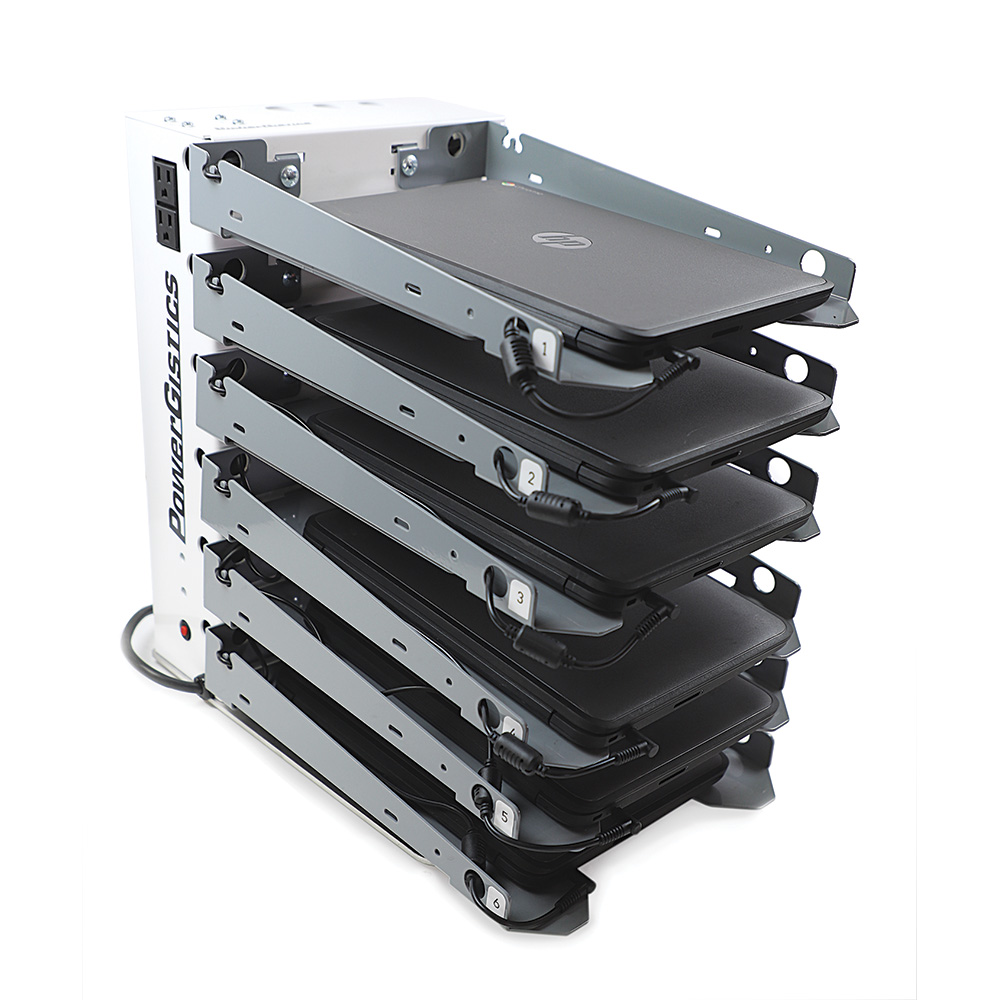District Solution for Students Forgetting to Charge Devices
August 31, 2023
 Since going 1:1 with devices, Clarence CSD struggled with students bringing charged devices to school. The district decided an in-class back-up charging solution was necessary to keep lessons moving forward and give students more educational time. Bob Raineri, Director of Technology of Clarence CSD in Clarence, New York, discusses the district’s solution to the uncharged devices issue.
Since going 1:1 with devices, Clarence CSD struggled with students bringing charged devices to school. The district decided an in-class back-up charging solution was necessary to keep lessons moving forward and give students more educational time. Bob Raineri, Director of Technology of Clarence CSD in Clarence, New York, discusses the district’s solution to the uncharged devices issue.
The Problem
“The main reason we started looking for a desktop option was that students were not remembering to charge their devices. Our main goal – to provide a solution so that students, teachers, and staff could charge devices up during the day.”
 Handing Out Chargers Was Expensive
Handing Out Chargers Was Expensive
“We had chargers that we deployed in each room, and then they would go missing. We were spending money on buying new chargers and we kept redistributing them to students. We understand that students could misplace their chargers, and we will continue to replace the chargers. But we thought, what can be a better solution for us?”
Download the Case Study PDF
Primary Pain Points:• Students coming to class with uncharged devices • Excessive loss of charging cables • Carts take up too much space Solution:• Desktop6 Plus’s in classrooms and common space for students to charge devices • Desktop6 Plus’s in libraries and offices to hold loaner devices Students and staff at Clarence Central School District easily charge their Chromebooks, tablets and laptops. Devices are a mainstay in education, and the need to charge them will always be present. With desktop charging stations throughout their schools, Clarence students and staff now have an easy, space-saving and quick solution to stay powered up, and gain more educational time. |
|
Carts Were Too Big
“We had carts historically for students that needed an hour or so charge during the day. Carts are just not the best solution for us. They are bulky and take up a lot of space in the room. Granted, carts got better over time but when we first had them they were very large. Then companies downsized them a little bit but carts are a big investment, too. Not that PowerGistics wasn’t a big investment, but it provided the solution we were looking for and teachers don’t have to move it every time they have to get to a desk or bookshelf.”
“A lot of people are thankful that we are giving them a managed charging solution that is a small footprint, specifically a smaller footprint than the cart. We were replacing a cart that is a lot bigger than the one and a half square foot that this takes up.”
— Bob Raineri, Director of Technology, Clarence CSD
Charging Stations in Multiple Locations Provides Charging for All
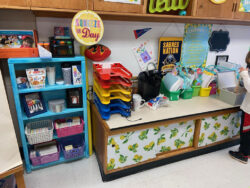 “PowerGistics Desktop6Plus was a better solution for us. Not only do we use it in classrooms, but we also use it in libraries as a charging station for students – we have different types of chargers in there for them. We also use it in our office to charge all our loaner devices and devices for testing. We use it in all our main offices for laptop loaners when substitute teachers come in. Instead of having wires all dangling everywhere, we were able to zip-tie the cables onto the charging stations. We try to centralize them within buildings and common areas. We’ve offered them to every elementary classroom and many have one deployed and set up in their room. I think it’s working well for us.”
“PowerGistics Desktop6Plus was a better solution for us. Not only do we use it in classrooms, but we also use it in libraries as a charging station for students – we have different types of chargers in there for them. We also use it in our office to charge all our loaner devices and devices for testing. We use it in all our main offices for laptop loaners when substitute teachers come in. Instead of having wires all dangling everywhere, we were able to zip-tie the cables onto the charging stations. We try to centralize them within buildings and common areas. We’ve offered them to every elementary classroom and many have one deployed and set up in their room. I think it’s working well for us.”
Used by All Grade Levels
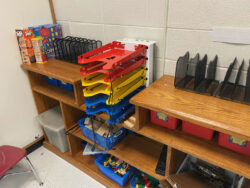
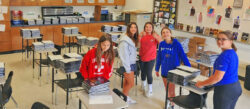 “We purchased these for use K through 12. In the classroom, it’s mainly K through 5. Some of our classes where students are in the same classroom all day, have stations in the room as well. For K through 5, some students take devices home every day and some stay in the classroom. Teachers can rotate them on the chargers as they need to. K-1 mainly does not take devices home every day but 2nd grade and up they are often traveling with them daily.”
“We purchased these for use K through 12. In the classroom, it’s mainly K through 5. Some of our classes where students are in the same classroom all day, have stations in the room as well. For K through 5, some students take devices home every day and some stay in the classroom. Teachers can rotate them on the chargers as they need to. K-1 mainly does not take devices home every day but 2nd grade and up they are often traveling with them daily.”
Teaching Personal Responsibility
“The only quasi-challenge that we have is that the student can’t use their device while they’re charging it. Part of a student’s responsibility includes that they should come to school with their school-issued device charged – it’s a teaching moment. If the student comes to school with a device that is not charged they will need to go to the library and get a loaner while their device charges. Similar to the concept if they forget their notebook. What do schools do if a student doesn’t have a paper to write on, not give it to them? No, we’re going to give them paper. So we’ve got a system set up for loaners when students forget them at home as well.
“The principals were just as excited to have them as we were and the students
in the elementary schools like the colors, it’s a little added pizzazz.”
-Bob Raineri, Director of Technology, Clarence CSD
Small Footprint to Replace the Cart
 “A lot of people are thankful that we are giving them a managed charging solution that is a small footprint, specifically a smaller footprint than the cart. We were replacing a cart that is a lot bigger than the one and a half square foot that this takes up.”
“A lot of people are thankful that we are giving them a managed charging solution that is a small footprint, specifically a smaller footprint than the cart. We were replacing a cart that is a lot bigger than the one and a half square foot that this takes up.”
Standard Power Accommodates all Needs
“Our classrooms mainly have all Chromebook chargers on the charging units. In our offices, some of them have a different type of charger for the devices that they are using. So we’ve wired a couple of Desktop6Plus’s for those devices and use cases.”
Ease of Setup
 “These were great for our summer helpers to set up. We usually get a couple of graduating seniors to come help us for the summer and we saved that project for them. The back case is really hard to get on and off. That was their only complaint, and it’s not really a complaint. It could be a good thing in the field because we don’t want anyone easily accessing the chargers.”
“These were great for our summer helpers to set up. We usually get a couple of graduating seniors to come help us for the summer and we saved that project for them. The back case is really hard to get on and off. That was their only complaint, and it’s not really a complaint. It could be a good thing in the field because we don’t want anyone easily accessing the chargers.”
Charging Available at Home and School
“I don’t think our students lose chargers at the same rate that they’ve lost them in the past. They aren’t losing them at school as often; and less often at home or on the bus. There are chargers in the desktop unit at school, and each student is assigned a charger when they get their Chromebook. I don’t think they’re missing out on educational time with these units and processes that we have put in place.”
“I don’t think they’re missing out on educational time with
these units and processes that we have put in place.”
-Bob Raineri, Director of Technology, Clarence CSD
Sustainable Charger Loss
“Last time we bought a large batch of chargers they were about $26 each. We brought all the devices back in from our 1:1 deployment so that we could assess and evaluate our 1:1 device deployment and charging needs. After that, we gave every classroom an extra charger because that was all we had. Then we bought the desktop charging units and chargers to go in all of them. It helped in such a way that students were no longer traveling as often with chargers and gave us the ability to build a stock so that we could sustain a lesser number of chargers being replaced each year, instead of a substantially large amount.”
How did you decide on PowerGistics?
 “We talked about the carts, moving them around, and the space they take away from the classroom. To be honest, after I saw this one, it fit the need. We got the demo unit and showcased it to principles. We asked them ‘Is this going to work? Do you think this is going to be a good solution for your classrooms?’ The principals were just as excited to have them as we were and the students in the elementary schools like the colors, it’s a little added pizzazz.”
“We talked about the carts, moving them around, and the space they take away from the classroom. To be honest, after I saw this one, it fit the need. We got the demo unit and showcased it to principles. We asked them ‘Is this going to work? Do you think this is going to be a good solution for your classrooms?’ The principals were just as excited to have them as we were and the students in the elementary schools like the colors, it’s a little added pizzazz.”
Multiple Desktops Suit Specific Spaces
“Our libraries have multiple PowerGistics stations, and some of the offices have multiple because they have more than 6 units that they sign out daily. The classrooms that have asked for multiple units were primarily classrooms where students remained in the same classroom for the majority of their day. This solution confines the wiring all to one spot; it tidies it up nicely so you don’t have power cords dangling around causing other potential hazards.”
Versatile Device Accommodation
“We have ours mainly wired for Chromebooks. Some classrooms have tablets so these are great for flexibility if a different charger type is needed. In our IT space we have it wired for Chromebooks, iPads, old iPads, older chargers, and newer chargers, so it’s efficient for us when we have to test something we have a device that’s readily available and charged.”
Student Use in Common Areas
“Students can come into the library for study hall, for instance, and they can put their device(s) on a charger. All of our devices are labeled with names, so people know it’s theirs when they go to pick it up. I’m grateful that we have that ability to offer this solution to our clientele.”
“Full power charging is helpful. Some of our libraries have tabletop USB chargers but these units allow us to charge a lot quicker because it’s full AC power.”
Outcome• Students have a classroom charging station for backup charging. • Fewer lost chargers reduces the expense of new charger purchases • Less instructional time is lost |
 The Clarence Central School District
The Clarence Central School District
Tradition, innovation, and teamwork are hallmarks of the Clarence Central School District. Although formally established in 1946, the District can trace its roots back to 1805 when early settlers built the first schoolhouse in a small clearing near what is now the intersection of Ransom Road and Main Street. That pioneer spirit, a willingness to work together, and a steadfast commitment to high standards continue to be key to Clarence’s success.
Download the Case Study PDF
 DESKTOP6 PLUS Custom
DESKTOP6 PLUS Custom
Custom colored 6 shelf desktop storage and charging includes an 8 outlet power strip in the back with power cord, 2 additional standard plugs on the side, and snap off back cover. For devices up to 14.75”.
Maximum device dimensions H 2.0” x W 14.75” x L 10.5”
Dimensions: H 17.75” x W 11.75” x D 18.75”
Power Supply: 8 Outlet Power Strip 120V,15A Circuit Breaker For Standard 110V Outlets
Shelf Spacing: 2” Cord Length: 12’ Assembled Weight: 23lb

 Handing Out Chargers Was Expensive
Handing Out Chargers Was Expensive
 The Clarence Central School District
The Clarence Central School District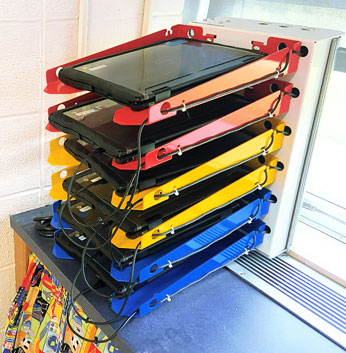 DESKTOP6
DESKTOP6 